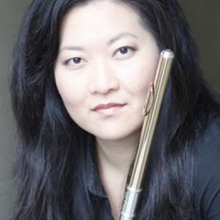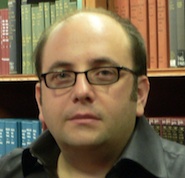Last year, New York composer Daniel Felsenfeld tapped out a message to his 1,500 Twitter followers, asking if anyone had a copy of the current issue of Flute Talk magazine. He’d heard there was a glowing review of his piccolo piece, All Work and No Play, which Metropolitan Opera piccolo player Stephanie Mortimore had premiered at Carnegie Hall. He didn’t want to buy a year’s subscription to Flute Talk in order to read it.

Bay Area flutist Meerenai Shim, who’d been following Felsenfeld’s Twitter musings for several months, had the magazine, and sent it to him via snail-mail. He e-mailed her to say thanks, and offered to pay her back the postage. Shim jokingly told him to take it off her bill when she commissioned a piece from him. But the joke became a reality: A few months later, Shim commissioned the composer, whom she’d never met, to write a work for flute, cello, and piano.
She paid for the piece, which she’ll premiere in April at Berkeley’s Trinity Chamber Concerts, by raising more than $5,000 on Kickstarter, the online funding platform for creative projects. Friends, strangers, and people whom she and Felsenfeld had met on the Internet kicked in an average of $25.
“Twitter is the best thing that has ever happened to my musical career,” says Shim, 35, a freelance musician and flute teacher who lives in Campbell. “For networking, it’s unbelievable. I have connected with all kinds of people from all over the world.”
So have countless other classical musicians who’ve embraced social media in the last few years. They range from fledgling artists who don’t have record companies or publicists to promote them, to stars like Hilary Hahn, Michael Tilson Thomas, and the Kronos Quartet, who use Facebook and Twitter to engage directly with their fans and give them a richer sense of who they are and what they do.

“It used to be you could go to a coffee shop or a bar and meet like-minded people. “Now Twitter, weirdly, serves that purpose,” says Felsenfeld, a Brooklyn-based composer who’s the guest curator and occasional writer of The New York Times’ online commentary series “The Score,” which features the writings of contemporary composers. “It gets you thinking as a member of a community.”
Felsenfeld’s commission from Shim wasn’t the first he’d received online. A conductor named Armando Bayolo, whom the composer had met on Facebook and who dug his music, commissioned Felsenfeld to write a 30-minute oratorio for chamber orchestra, chorus, and two soloists, for the Great Noise Ensemble of Washington, D.C. The work premiered at the Kennedy Center in 2010.
The Right Tools for the Job
For classical music organizations, Twitter, Facebook, and YouTube have become essential tools for communicating with audiences, giving fans both a kind of backstage access and a way to connect with musicians and other music lovers.
“So many people are online, not just the younger demographic, but people of every generation. We need to be online to make sure we speak to them,” says San Francisco Opera Marketing Director Marcia Lazer.
“Using Facebook, Twitter, YouTube, and other forms of social media is not optional — these tools are central to the way people communicate.” – Jean Shirk
Jean Shirk, the San Francisco Symphony’s public relations manager, who’s in charge of the Symphony’s extensive social media efforts, puts it this way: “Using Facebook, Twitter, YouTube, and other forms of social media is not optional — these tools are central to the way people communicate and share information now. ... We’re simply going where the audience is.”
The Opera got serious about social media in February 2010, when it formed a Facebook committee comprising staffers from departments across the organization. They meet weekly to talk about what should be posted on its Facebook page and tweeted. The Opera also hired social media consultant Nancy Roberts, who does the actual tweeting.
The Opera’s Twitter feeds are pitched at the general arts community, as well as at hardcore opera fans. A recent tweet asked, “Cinci Symphony experiments with Tweet Seats - good idea or no way?” It was followed by a link to a story about the Cincinnati Symphony encouraging a small group of patrons to tweet about the music while listening to the orchestra perform it live at Music Hall.
Sometimes the Opera, which has 3,613 Twitter followers, retweets Twitter remarks by singers like baritone Thomas Hampson. Unlike many prominent musicians, among them composer Steve Reich and pianist Yefim Bronfman, whose tweets and Facebook postings are written by their publicists or publishers, Hampson does much of his own tweeting. (Hilary Hahn writes all her own snappy Twitter feeds, under the guise of her violin case.)
Organizations don’t yet have the “metrics” to measure what effect all this conversing is having on ticket sales. But there is a strong feeling that social media, which encourages lively and informal interaction, is expanding audiences.
“We certainly have evidence that new people are coming to our concerts all the time, by reading what people say on Facebook and Twitter,” says the Symphony’s Shirk.
Audience-Booster Paying Off
Janet Cowperthwaite, the managing director of Kronos Quartet and its performing arts organization, can’t quantify it, “but my sense is that social media is increasing the audience for Kronos and for its music,” she says. “We wouldn’t keep doing it if it weren’t.”
There is a strong feeling that social media, which encourages lively and informal interaction, is expanding audiences.
The famously forward-looking San Francisco string quartet, which has a passionate international following, has been ahead of the social network curve. It started a Myspace page in 2005, and now has 65,000 friends on the site, which is no longer vital in the U.S. but is still big abroad. The group worked with Facebook designers to develop the concept and look of the Facebook band pages, which launched in 2007. It now has more 35,000 Facebook fans, 12,000 of whom came aboard in the last year.
Kronos puts things up on Facebook or Twitter that fans won’t find anywhere else, at least initially. It could be the photo of violinist David Harrington backstage with Noam Chomsky at MIT last April before the quartet premiered Tod Machover’s Chomsky Suite, or a video of Steve Reich talking about a new work he’s rehearsing with the quartet.
“It’s like giving fans a backstage pass,” Cowperthwaite says. “The musicians have to be willing to reveal more of what goes on behind the scenes. It’s a more candid, informal way of communicating. People feel more engaged, not only in the end result, the concert, or the recording, but in the process involved in getting there.”
The Kronos musicians don’t have the time or the desire to do their own tweeting. That task falls to their communications manager, Christina Johnson, who often travels with them. She tweets from places like London’s Barbican Centre, where last May she wrote, “Catching some of @bangonacan doing brian eno's music for airports in the lobby of @barbicancentre http://yfrog.com/gzdxieaj.” A few days later, she posted photos of the quartet rehearsing in a Glasgow mausoleum.
The San Francisco Symphony’s music director, Michael Tilson Thomas, also got hip to the power and possibilities of social media early on. He’s the artistic advisor and conductor of the experimental YouTube Symphony Orchestra, whose March 2011 concert in Sydney was streamed on YouTube a record 33 million times to 189 countries. MTT also has a large Twitter following — 35,847 as of last week.
“Social media is the logical step for singers to connect with the public. ... I want them to connect with me, Leah.” – Leah Crocetto
“Back home in SF,” he wrote on Sept. 2. “Late summer fog rolling in. First rehearsals tomorrow. Looking forward to seeing the band.”
Last month, he tweeted, “@SFSymphony concert tonight Gil Shaham played transcendent Brahms. A treat to accompany.” A few weeks earlier, there was a picture of MTT holding a giant green squash with the comment, “At SF Farmer's Market. Fantastic Winter Squash!”
Live Updates From Backstage
The rising soprano Leah Crocetto tweets about food sometimes, too, as well as about rehearsing Verdi and Rossini, working out at the gym, and indulging her passion for the TV show Parenthood. She tweeted often from backstage at the San Francisco Opera last month, when she played Liu in Turandot. Sometimes she pecked out messages during intermission, or at other times while waiting in the wings. “Intermission @SFOpera Turandot!! Feeling good ... had such a good time during Act 1!!!,” she tweeted on Nov. 18. That same evening she wrote, “Walter Fraccaro is singing Nessun Dorma right now ... he is amazing!”
Fracarro’s performance “was especially beautiful that night, so I felt like sharing it,” says Crocetto, 31, talking on the phone after rehearsing for her final recital as an Adler Fellow. “It brings people closer to the art.”
The soprano, who tweets several times a day, responds to everyone who tweets her, whether it’s a fan or a fellow musician like tenor David Lomelí.
“Social media is the logical step for singers to connect with the public,” says Crocetto, who has 493 Twitter followers. “So many younger people — the next generation of opera fans — and people who are in their 30s, 40s, and some in their 50s and 60s, are on Facebook and Twitter. They’re wired in. It’s a great way to build a fan base and humanize people who are onstage.
“I want to make myself familiar to the audience, and social media creates a unique rapport. I want people to connect not just with Liu, or Leonora, or whatever character I’m playing. I want them to connect with me, Leah.”
